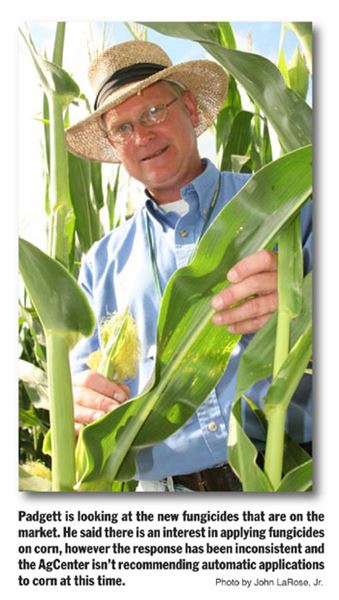Identify The Problem
Researchers Seek Ways To Help Farmers Manage Disease, Pests
ST. JOSEPH, LA.
Disease management in row crops was discussed
recently by Dr. Boyd Padgett of the
LSU AgCenter located at the Macon Ridge
Research Station near Winnsboro, La. Padgett
spoke at the Northeast Research Station Crop
Production and Pest Management Field Day.
Padgett discussed what the AgCenter is doing
to address the management of various diseases,
specifically in corn, cotton, soybean, milo and
wheat.
“We have a number of different diseases that
we deal with year in and year out,” he said. “I
outlined various techniques that farmers can
utilize to manage disease in these crops, what
techniques are most effective and which ones
they should avoid.”
“We would like our producers, our agents and
our specialists to leave from this stop with something
that they can actually use immediately
when they leave,” he continued. “We’d also like
to thank our funding sources, Cotton Incorporated,
the Louisiana Soybean and Grain Promotion
and Research Board and industry for
providing funds for our research, which I could
not do without.”
Presently, Padgett is looking at the new fungicides
that are on the market. There are a few
new foliar applied fungicides for soybeans.
“There is also an interest in applying fungicides
on corn,” he said. “The response has been
inconsistent and the AgCenter isn’t recommending
automatic applications to corn at this
time. We’ve also looked at various seed treatments
in cotton. These treatments provide protection
against seedling disease, and nematodes.
Some early season insects and new seed treatments
in cotton. There is a place for these products.
As far as wheat, we have to deal with leaf
or stripe rust almost every year. We’re trying to
find the mix for utilizing a resistant variety and
whether or not they need a fungicide.
“Based on our research, a good disease resistant
variety has not benefited from a fungicide.
However, the organism causing rust is highly
adaptable, and genetic resistance can breakdown;
therefore it is important to have effective
fungicide programs set up.”
Asian Soybean Rust has been a hot topic,
though it has died down a bit.
“We don’t want to be complacent about it,” he
said. “We’re looking at fungicides, of course
we’re looking at genetic resistance as well to see
what would be the best way. We’re conducting
research all over the state, not only at this experiment
station, but also in south Louisiana
and central Louisiana. Actually, tomorrow I’m
going over to the northwest part of the state to
do some work there. So we try to cover the entire
state so all of our producers have solutions to
their problems.”
Padgett said the use of fungicide in corn is relatively
new and there’s some controversy about
whether these fungicides should be utilized as
an automatic application in the absence of disease.
Soybean rust, even though it’s died down, is
still in the back of people’s minds. Soybean rust
was seen in South Louisiana even before July.
“So growers and consultants are a little cautious
about that, and there have been questions
about the new chemistries that are available,”
Padgett said. “That is a hot topic. These newer
fungicides are more effective against rust than
what we originally had.”
Speaking of cotton, Padgett said cotton already
comes with a seed treatment, however new seed
treatments will provide additional protection
against seedling disease.
“There is an insecticide component which
seems to be effective under certain conditions,”
he added. “They all have their limitations, and
the nematode component is probably more limited
than the other two components; it’s not
going to be targeted for fields that have a severe
problem with nematodes. I have seen that the
seedling disease component is pretty effective
during short periods of adverse weather. I think
growers just need to realize that it doesn’t last
forever and it probably would not last as long as
an in-furrow applied product.
“It makes sense that there would be more
residual activity if you pour a gallon of water on
the ground as opposed to just a little cup of
water,” he suggested. “Both of them are water,
but where you saturate the ground more it’s
going to stay wet longer. Same thing with these
chemistries. So we’re excited about that; it offers
growers convenience, they don’t have to calibrate
equipment and they really like these seed
treatments.”
There are some limitations and sometimes
people get blinded by the convenience, so it’s the
researcher’s job to show them how these products
work. They work under certain conditions
and removed from that area they may not work,
they may not be as effective. Actually, it’s up to
each individual farmer to make the call after
checking the data.
“The main thing we want growers to do is to
identify what problems are associated with individual
fields,” Padgett said. “If you don’t have nematodes
you don’t need a nematicide. If you
have a problem with seedling disease you may
need to go up to the next level. You may need to
go beyond a seed fungicide treatment. So it’s important
that you know what problems you’re
dealing with, and that goes with anything in life.
If you’re going to manage a disease the first
thing to do is to identify what is causing it; if you
go out shooting the wrong bullet, so to speak, at
the wrong disease it’s not going to work. So we
encourage growers to scout their fields, identify
what disease problems they have that are associated
with those fields and then take action.” Δ
BETTY VALLE GEGG-NAEGER: Senior Staff
Writer, MidAmerica Farmer Grower
